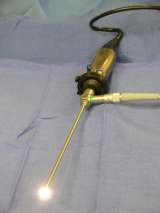Endoscopic Pituitary Surgery
Find your care
We treat pituitary tumors using the latest innovations in minimally invasive procedures. To connect with an expert in the pituitary tumor program, call 310-825-5111.
Advantages of endoscopic pituitary surgery
UCLA Pituitary Tumor Program surgeons routinely use a purely endoscopic technique to remove pituitary tumors. The endoscope has revolutionized the surgical treatment of pituitary tumors. When used with an expanded endonasal approach (EEA), endoscopy allows:
- The ability to see and remove tumors in otherwise difficult to reach areas.
- The detailed, high-resolution view of the operating field.
- Your neurosurgeon's ability to perform precise movements using the microsurgical instrument.
Your doctor inserts the endoscope and instruments through your nose, eliminating the need for a facial incision. There is no visible scar and fewer side effects. You are often able to go home the day after surgery.
What is an endoscope?

UCLA surgeons use an endoscope, a narrow tubular instrument only 4 mm in diameter, that is inserted through the nostril. The endoscope brings the viewing lens close to the working area, providing a high resolution, magnified view of the tumor and surrounding important structures. Special microsurgical instruments are used alongside the endoscope for dissection and tumor removal.
How is endoscopic pituitary surgery done?
The wide exposure and incredible visualization provided by the Expanded Endonasal Approach allows the surgical removal of tumors sometimes considered "inoperable" by traditional techniques. The expanded endonasal approach requires special training and a teamwork approach between an endoscopic sinus (Head and Neck) surgeon and the neurosurgeon. The UCLA pituitary tumor surgical team is one of the few in the country utilizing this revolutionary technique.
Watch an endoscopic pituitary tumor surgery video
Is endoscopic surgery right for me?
You should ask your neurosurgeon if endoscopic surgery is appropriate for your tumor type and location, and always consider a second opinion. In some cases, an alternative minimally-invasive technique may be advantageous. UCLA neurosurgeons have extensive experience with all of the various techniques, including minimally-invasive "key-hole surgery" using the eyebrow to hide the incision.
Contact Us
To schedule an appointment with one of our physicians at the Pituitary Tumor Program, please call (310) 825 5111.